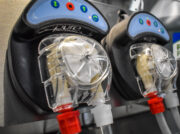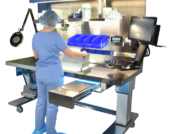
Can You Count On Syringes for Effective Surgical Instrument Cleaning?
Syringes are a common flushing solution to remove bioburden from lumened or cannulated surgical instruments. They are still used by reprocessing departments today, despite newer solutions being available. It’s time to take a deeper look at syringe flushing issues if you’re one of those departments.
Evaluate syringe flushing practices
You’re likely aware of syringe shortcomings if your instrument reprocessing department uses them to flush bioburden from instruments. You may have delayed a change in favor of other priority projects. But it’s time to reprioritize this issue.
Consistent, standardized instrument flushing according to guidelines reduces the likelihood of healthcare-associated infections (HAIs). We can all agree that’s important, not only for patients, but for clinicians and healthcare facilities as well. And the simple fact is syringes miss the mark. 34% of surgical site infections (SSIs) derive from inadequate cleaning before sterilization.1 Effective surgical instrument cleaning should be a priority to reduce that number.
It’s time to evaluate your departmental syringe flushing practices for efficiency and accuracy. You’re likely to discover the following issues.

Inconsistent flushing practices
Manual cleaning compliance is critical to reducing the likelihood of a surgical site infection. It would be ideal if everyone could flush exactly the same. But the reality is no two technicians or nurses do so. That leads to inconsistent syringe flushing, which does not meet surgical instrument cleaning IFUs. IFUs cannot be met if technicians flush differently from each other, or if technicians flush differently throughout their shift.
Cleaning surgical instruments takes more time
Syringes can only flush one instrument at a time. Newer options enable technicians to clean multiple devices at once, and even engage with other tasks such as brushing complex pieces on devices or preparing the next tray for cleaning.
It has also been the case, that surgical instrumentation has become more complex and detailed in recent years. Certain surgical specialties will have instrumentation with multiple ports, or surgical cases will increase the number of instrumentation per case. This makes the demand on nurses and technicians more significant and keeping up with case carts more strenuous.
Repetitive motion injury risk
Ergonomics is a key factor for technician success because repetitive motion injury can have lasting impacts for a sterile processing department and the entire team. Plunging and pulling 250mL can require as many as 10 syringe flushes. Imagine the impact to your technicians’ hands and wrists as they use 10 syringe fills to clean each instrument.
Loading and depressing a syringe repeatedly is not only uncomfortable, but also an exponential injury risk to your technicians over time. That can become a staff safety issue, or even a satisfaction concern.
Syringe waste impacts the environment
Most departments using syringes for flushing open a new syringe for each instrument (or have to take the time to disinfect the syringe between them). The excess use of syringes could add to landfill waste with potential negative impact on the environment. It’s also a consistent and unnecessary expense to the department.
Surgical instrument cleaning: A solution for syringe flushing issues
After evaluating your department for these four syringe issues, you’ll likely wonder how to overcome them. The good news? There is a simple solution that can solve them all.
The FlexiPump™ Independent Flushing System was designed to flush internal instrument channels hands-free, and meet manufacturer’s IFU as well as standards and guidelines. It resolves the above four syringe shortcomings in the following ways:

- Consistent internal device channel and lumen flushing during manual and pre-cleaning to meet IFUs
- Can flush up to three instruments at once for efficiency and throughput
- Eliminates repetitive motions associated with syringes
- Is a reusable device that eliminates syringe waste
Central Sterile Manager Matt discovered switching from syringes to the FlexiPump made manual cleaning easier. “It made decontamination for canulated instruments a lot easier for not just the [robotic instrumentation], but for everything.” He also found it made things a lot easier for the staff overall.
Every sterile processing department strives to meet standards, ensure the safety of reusable medical devices, and increase safety for patients. Flushing surgical instruments with syringes in past years was an acceptable practice. But recent improvements are available to help you meet all those goals you strive for, including staff safety and satisfaction.
It’s time to take a deeper look at syringe flushing issues. You just can’t count on syringes for effective surgical instrument cleaning anymore.
Learn more about the Pure Processing FlexiPump Independent Flushing System and how it can ensure your surgical devices are cleaned according to IFUs, save your team valuable time, and reduce the risk of repetitive motion injury.
References:
- Emergency Care Research Institute. If it’s not clean, it’s not sterile: Reprocessing contaminated instruments (2017). Retrieved May 25, 2021 from the www.ECRI.org website. https://www.ecri.org/components/PSOCore/Pages/e-lert041117.aspx




